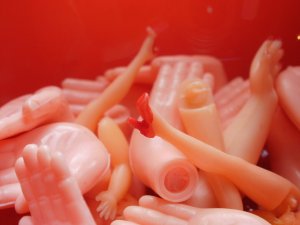Identifying Your Cabbage Patch
. (The Coleco Dolls) The success of The Cabbage Patch Kids by Coleco created many imitators. In the
years of 1983 and 1984 they went by the names of: Cauliflower Kids,
Flower Kids, Pumpkin Kids, Kraut Kinder, Broccoli Kids, Copies of
the four original head molds with the copyright were made in the
Asian Factories. As well as knock offs of the boxes and certificates
of birth and adoption. Even Xavier Roberts signature on the
buttocks was copied. The only thing that was not copied was the
body tag on the authentic Cabbage Patch Kids. These body tags are
very helpful in identifying the authentic Cabbage Patch dolls.
The real Cabbage Patch Kids of this era are identified by the by the
word "birthmark" on the head, cheek of the buttocks and the body
tag. On the authentic Coleco dolls of this time the copyright on
the back of the head reads, "1978, 1982 Original Appalachian
Artworks, Inc.". And may also include the line: "manufactured by
Coleco" or "Made In Hong Kong" Later Coleco Head molds say: 1978,
1982, O.A.A. Inc." or "Copyright 1982 – 1987".
(The Hasbro Dolls) In 1990 the first Hasbro dolls appeared on the
market. The posable Hasbro Kids have the marks: "First Edition,
Copyright 1990, O.A.A., Inc." Manufactured by Hasbro, Inc." This
inscription was used through 1994. Some molds have later dates, but
no longer say: "First Edition".
In the fall of 1994 Hasbro introduced two new molds for the fourteen
inch Cabbage Patch Kids. These have large raised Cabbage Patch logo
on the back of the head and reads: "Copyright 1994, O.A.A., Inc.,
Manufactured by Hasbro Inc.".
(The Mattel Dolls) The Mattel Kids arrived in August 1995. The
head molds were marked: "Mattel First Edition, Copyright 1978,
1982, O.A.A. Inc., Manufactured by Mattel," The "First Edition"
line was removed in 1997.
Another important identifier of The Cabbage Patch Kids is the body
tag. The body tag is a single or double cloth tag sewn into the
left seam of the cloth bodied dolls. Some of the early Coleco tags
were embroidered, but most were printed. Some of the tags by
Tsukada were bilingual often in both Japanese and English. The
Coleco tag has 1978, 1982, O.A.A., Inc., and has manufacturer and
the country in which manufactured. Most Coleco tags read "Made In
China", but the early 1983 tags read `Made In Hong Kong".
The Cabbage Patch Kids were made at a rate of 100,000 dolls a week
at Hong Kong's Kader Industries. Most of the cloth bodies and
clothes were made across the border in Mainland China.
Knowledgeable collectors of the Cabbage Patch Kids know the circled
initials on the Coleco tags are factory codes.
For the 1983 to 1986 Kids the initials on the tags give information
on the quality of the doll. The earliest Coleco Cabbage Patch Kids
were KT's with "Made In Hong Kong" on their heads and or body tags.
The Hong Kong KT's have thick hair and pretty facial coloring, but
some KT's have pale complexions and less detailed eyes, lighter
freckles and thinner hair.
The quality of the OK's is more consistent with distinct freckles,
pink cheeks, and hair; especially the 1986 nylon or popcorn styles
are considered high quality. Tags on Coleco kids with UT (1984 –
1985} and ICC (1985 – 1986) tags are less common and some of the
prettier dolls were made by these Taiwan factories.
